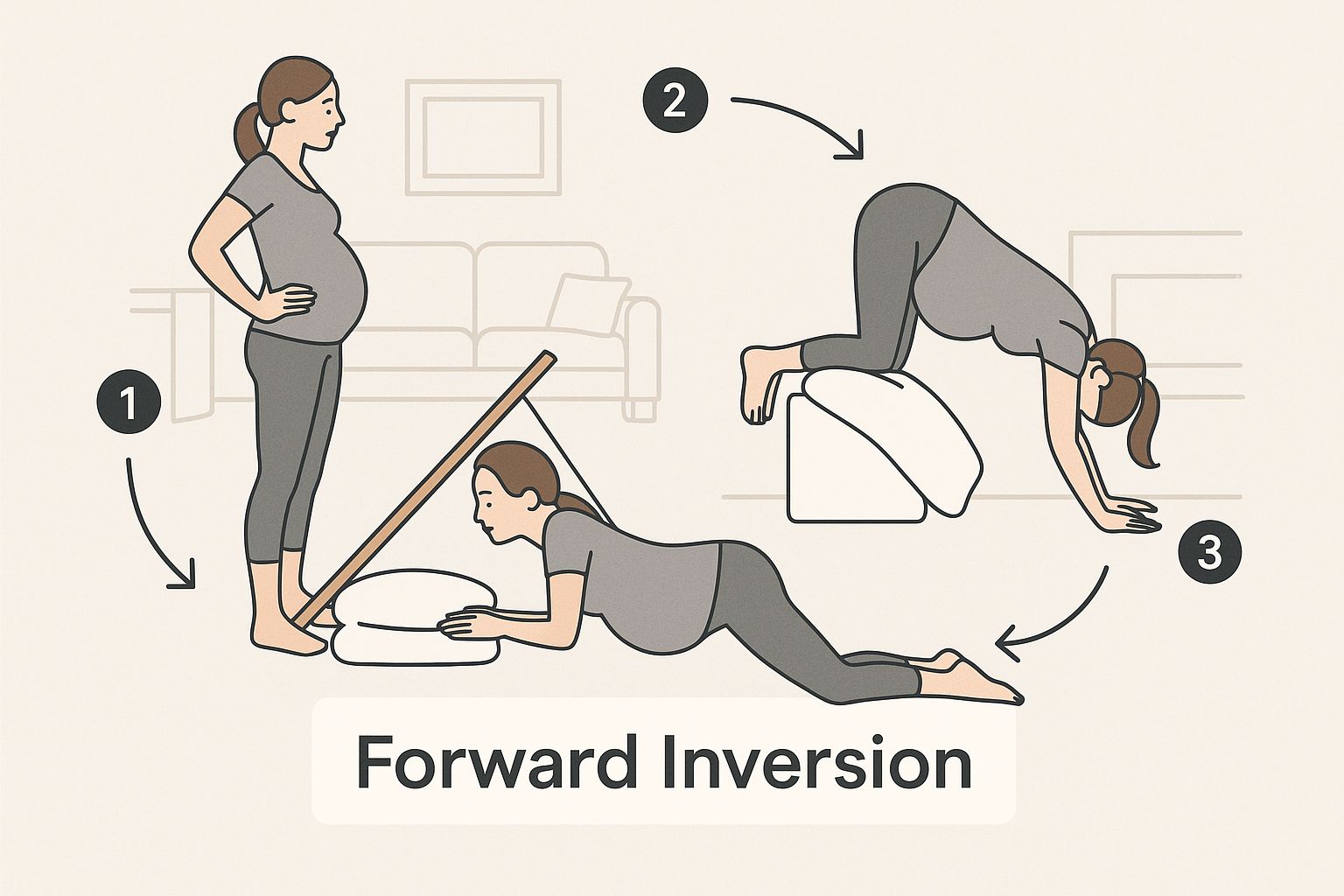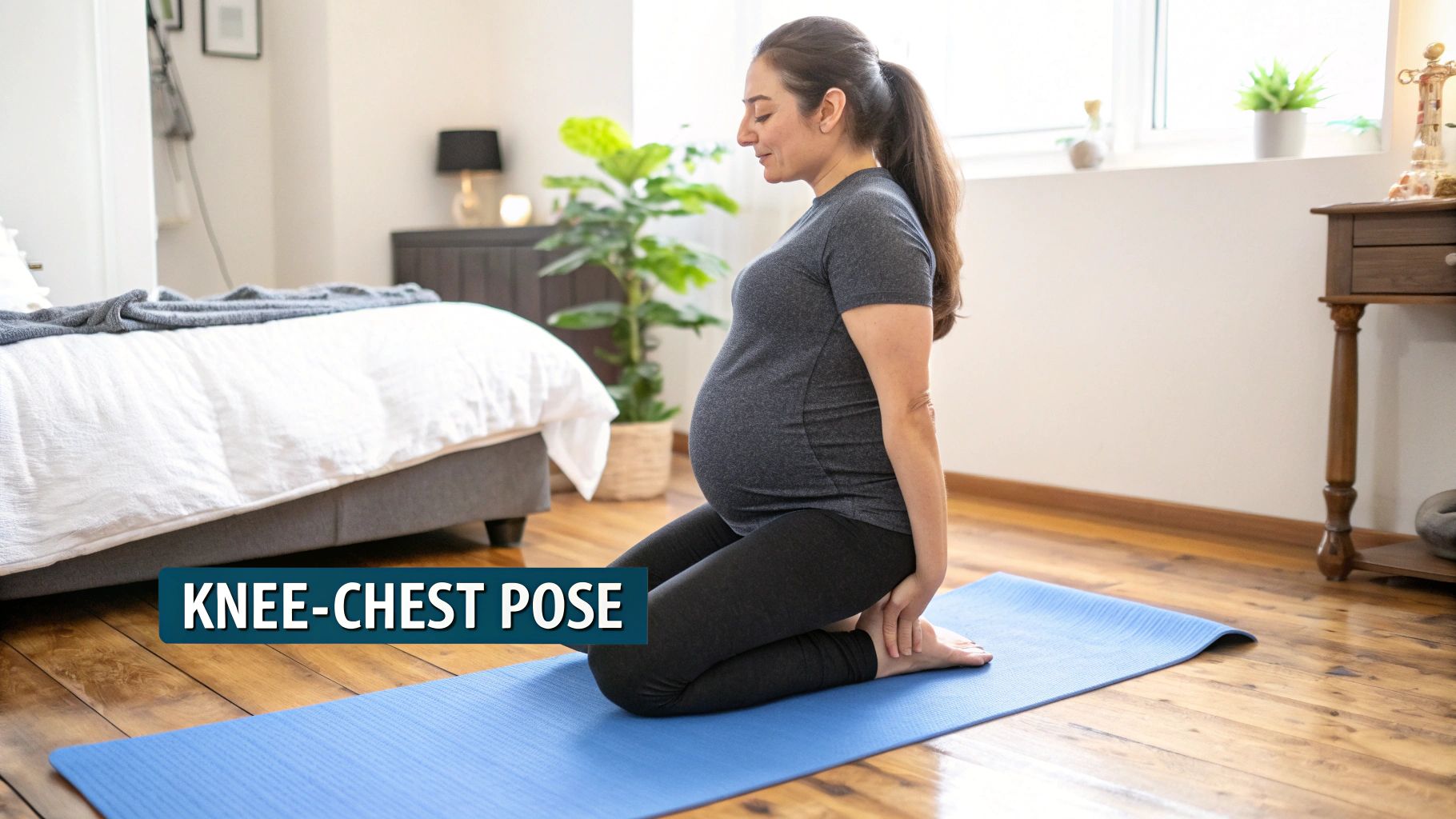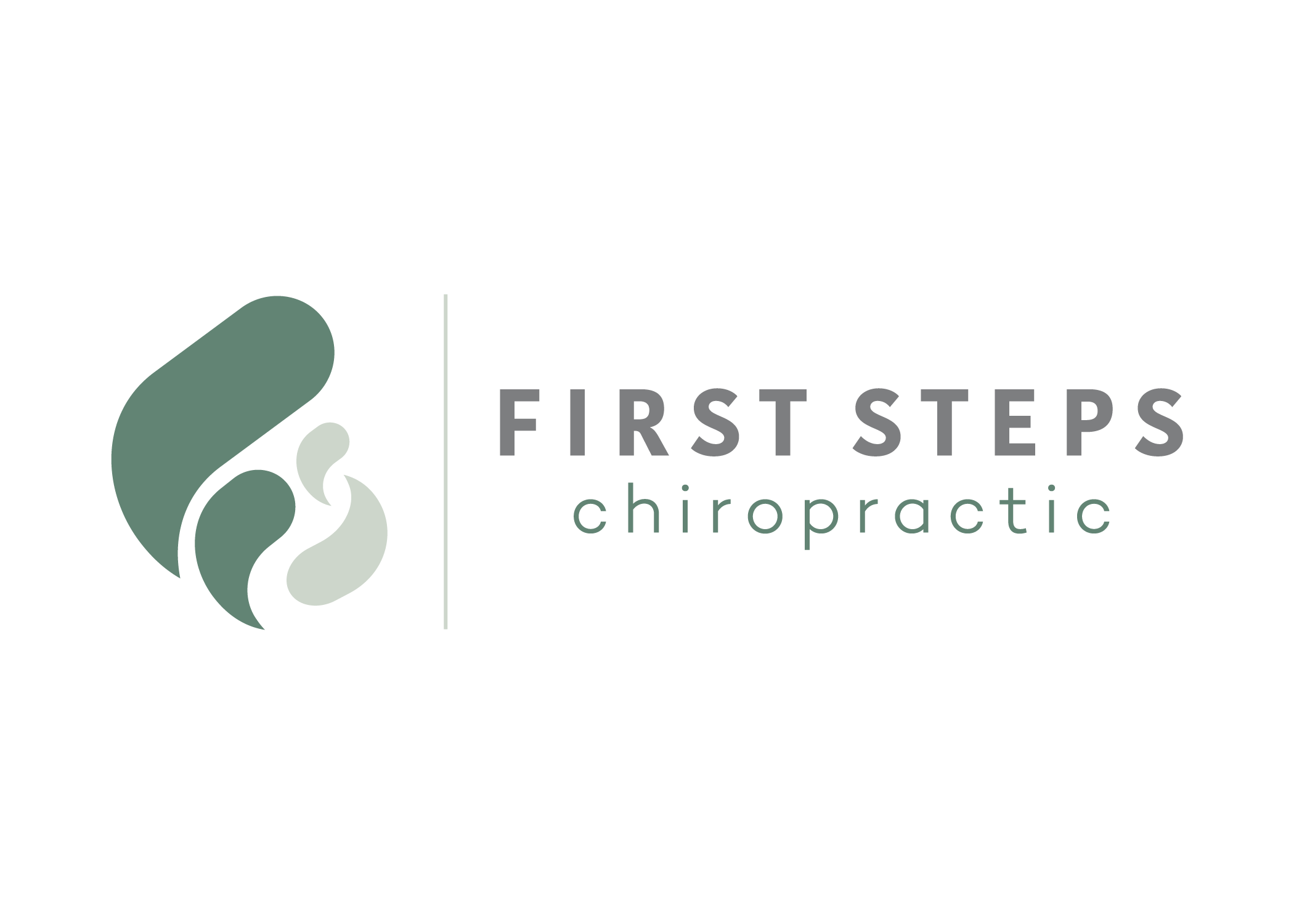When you find out your baby is in a breech position, it’s completely normal to feel a little worried. But I’m here to tell you that this is often just a temporary stop on their journey. A breech position simply means your little one is settled bottom-first or feet-first in your uterus. While it's pretty common earlier in pregnancy, most babies naturally find their way to a head-down position by week 36.
The great news is that you can play an active role. Gentle exercises and specific postures can help create more space in your pelvis, giving your baby the room they need to flip on their own.
Understanding Your Baby's Breech Position

Before you jump into any breech baby turning exercises, it’s helpful to understand what’s going on. A breech presentation isn’t something that needs to be "fixed"—it's just a variation of how babies can get comfortable. You’re definitely not alone in this; about 3-4% of all full-term pregnancies involve a breech baby.
Lots of things can influence your baby's position, like the shape of your uterus, where the placenta is attached, or even the amount of amniotic fluid. Sometimes, a baby just finds a cozy spot and decides to hang out there for a while. Knowing this helps us shift our focus from worry to gentle, proactive encouragement.
The Different Types of Breech
Not all breech positions are identical. Your midwife or doctor will be able to tell you exactly how your baby is positioned, usually through a physical exam or an ultrasound. This is key information for us.
- Frank Breech: This is the most common setup. The baby’s bottom is down, with their legs folded up straight in front of their body, feet near the head. They look like a little acrobat!
- Complete Breech: Here, the baby’s bottom is down, but their hips and knees are bent, almost like they're sitting cross-legged.
- Footling Breech: In this position, one or both of the baby's feet are pointing down toward the birth canal, meaning they would be born feet-first if they stay that way.
How Providers Identify a Breech Baby
Your care provider is an expert at figuring out your baby's position using a hands-on technique called Leopold's maneuvers. They’ll gently feel your abdomen to map out where the baby's head, back, and bottom are. If anything is unclear, an ultrasound gives a definitive picture.
Your provider will typically start paying closer attention to your baby’s position around 32-34 weeks. If your baby is still breech at 36 weeks, that’s often the perfect time to start a proactive routine of gentle exercises.
This timeframe is the sweet spot. Your baby is mature enough for the turn to be significant, but there's still enough room and fluid for them to move around. The goal of these exercises isn’t to force a turn, but rather to relax your pelvic muscles and ligaments. This creates an open, inviting environment that gives your baby the best possible chance to find that ideal head-down position all on their own.
With this understanding, you can approach the process with confidence and a clear sense of purpose.
Quick Guide to Breech Turning Approaches
There are several ways to encourage a breech baby to turn. Some are things you can do at home, while others involve a trained professional.
Here’s a summary of different methods to encourage a breech baby to turn, outlining their core principle and when they are typically considered.
| Method Type | Core Principle | Typical Timing |
|---|---|---|
| At-Home Exercises | Uses gravity and posture to relax pelvic ligaments and muscles, creating more space for the baby to turn. | 32-37 weeks |
| Chiropractic (Webster Technique) | A specific chiropractic adjustment that reduces sacral subluxation and balances pelvic muscles, which can help the baby turn. | 32-37 weeks |
| Acupuncture & Moxibustion | Uses traditional Chinese medicine techniques to stimulate points that encourage fetal movement and turning. | 34-36 weeks |
| External Cephalic Version (ECV) | A medical procedure where a doctor manually tries to turn the baby from the outside of the abdomen. | 37+ weeks |
This guide gives you a quick overview, but it’s always best to discuss these options with your healthcare provider to see what’s right for your specific situation.
Gentle At-Home Positional Techniques
You can start encouraging your baby to turn right from the comfort of your own home using gentle, non-invasive positions. These techniques work with gravity, not against it, to create more space in your pelvis. The idea isn't to force a turn, but to make the environment so inviting that your baby chooses to move on their own.
One of the most effective at-home breech baby turning exercises is the forward-leaning inversion. This posture helps lift your baby’s bottom out of the pelvis, giving them the room they need to perform a little somersault into a head-down position. It’s a simple yet powerful way to use gravity to your advantage.
The following infographic illustrates how to safely perform a forward inversion, a key positional technique.

This visual shows how elevating your hips creates a gentle slope, encouraging your baby to move upward and out of the pelvic brim.
Creating Space with Pelvic Tilts
Another fantastic technique is the simple pelvic tilt, often done on all fours. This movement helps to relax the muscles and ligaments around your uterus and lower back. Think of it as gently rocking your baby into a better position.
Here’s how to do a pelvic tilt:
- Start on your hands and knees with a flat back.
- Inhale as you let your belly drop down, arching your back slightly (like a "cow" pose in yoga).
- Exhale as you round your spine up toward the ceiling, tucking your chin to your chest (like a "cat" pose).
Repeat this fluid motion for several minutes, a few times a day. It’s a relaxing stretch that not only encourages your baby to turn but can also ease common pregnancy-related back pain. You can learn more about how to enhance your pregnancy journey with safe exercises and stretches that complement these techniques.
Key Takeaway: Consistency is more important than intensity. Aim to incorporate these gentle movements into your daily routine for short periods, such as 10-15 minutes, two to three times per day. This consistency helps maintain pelvic balance and space.
The Forward-Leaning Inversion in Detail
The forward-leaning inversion, while simple, requires careful execution to be both safe and effective. It's always best to have a partner or spotter nearby, especially as your center of gravity shifts in late pregnancy.
How to Perform It Safely:
- Starting Position: Begin by kneeling on the edge of a sturdy couch or bed.
- Lowering Down: Carefully walk your hands down to the floor, placing them flat. Your knees should stay on the elevated surface.
- The Inversion: Let your head hang freely and keep your elbows off the floor, supporting your weight with your hands. Hold this position for about 30 seconds—or three deep breaths.
- Coming Up: To get out of the position, walk your hands back toward the couch and push yourself up slowly to a kneeling position. Don't stand up too quickly.
It's absolutely crucial to listen to your body. If you feel dizzy, uncomfortable, or experience any pain, stop immediately.
This is one of the most talked-about breech baby turning exercises because it directly addresses the lack of space that can keep a baby from turning. By inverting, you gently "un-engage" the baby's bottom from the pelvis, creating a window of opportunity for them to flip. I recommend doing this once or twice a day, but always after getting clearance from your healthcare provider.
Using Strategic Rest to Encourage Turning
It might seem almost too simple, but the way you rest can be one of the most effective breech baby turning exercises out there. This low-effort approach, often called strategic side-lying, is all about using your body’s natural alignment to create just a little more space, gently encouraging your baby to tuck their chin and turn head-down.
Think of your uterus like a cozy hammock. If you lie on the same side where your baby’s back is nestled, gravity can actually encourage them to settle in even deeper, which makes a turn less likely. But if you switch to the opposite side, you open up the space right in front of them. This simple shift creates an invitation for them to roll forward into a more ideal, head-down position.
This isn’t about enforcing a rigid schedule. It’s about making a small but powerful adjustment to your daily naps or nighttime rest.
Determining the Best Side for You
First things first, you need to figure out where your baby’s back is. Your midwife or doctor can usually tell you this after an exam, but you can also do a little “belly mapping” at home.
Just lie down somewhere comfortable and gently feel your belly. You’re looking for a long, firm, and smooth area—that’s most likely your baby’s back. The other side will probably feel a bit lumpier, and you might feel little kicks and wiggles from their arms and legs.
Once you have a good idea of their position, the instruction is simple:
- If your baby's back is on your left side: Try to spend more of your resting time lying on your right side.
- If your baby's back is on your right side: Make a conscious effort to lie on your left side.
This small change in your resting posture can genuinely make a big difference. It's a completely passive technique, but it creates the perfect conditions for your baby to get moving on their own terms.
How to Get Comfortable with Strategic Side-Lying
Let’s be honest, staying comfortable while pregnant can be a challenge, especially when you’re trying to favor one side. This is where pillows become your absolute best friend.
- Start by placing a pillow between your knees and ankles. This helps keep your hips aligned and takes a lot of pressure off your lower back.
- Next, tuck a wedge pillow under your belly for support. This little lift can feel amazing.
- Finally, add another pillow behind your back to keep you from accidentally rolling over onto the less-desired side while you sleep.
This cozy setup not only supports your strategic resting goals but also promotes better circulation and can seriously improve your sleep quality.
Using posture to influence a baby's position isn't a new idea; it’s been recognized for a long time. One study even highlighted its effectiveness by comparing a group that used specific lateral positioning to a control group. The results were pretty compelling: the rate of babies turning head-down at term was 94% in the positioning group, compared to just 77% in the control group. That shows just how much of an impact a simple adjustment can have. You can explore more about these positional findings to see the research for yourself.
By simply shifting the side you rest on, you’re maximizing the space available for your baby. This technique doesn’t force a turn; it creates an open invitation for them to find their own way into the head-down position.
Does the Knee-Chest Position Really Work?

If you’ve spent any time researching how to turn a breech baby, you've almost certainly stumbled upon the knee-chest position. It’s one of the most widely recommended at-home techniques, and for good reason—it’s simple, non-invasive, and completely free.
The whole idea is to use gravity to your advantage. By getting into this position, you gently encourage your baby to lift out of the pelvis, giving them the space they might need to do a little somersault into the ideal head-down position.
How to Perform the Knee-Chest Position
Getting into this posture safely is the most important part. You don't need any fancy equipment, just a soft surface like a yoga mat or a plush rug.
- Get on all fours. Start on your hands and knees, making sure your hips are stacked right over your knees.
- Lower your chest to the floor. Gently walk your hands forward, lowering your shoulders and chest down toward the ground. Think of it like the "puppy pose" in yoga.
- Keep those hips high! The key here is to keep your hips elevated as much as possible. This creates a distinct downward slope from your pelvis to your head, which is what helps create that space for your baby.
- Relax and breathe. Turn your head to one side and just rest your cheek on the floor. Focus on taking deep, relaxed breaths for about 10-15 minutes.
- Be consistent. Most birth professionals suggest doing this two or three times a day. Try to do it on an empty stomach and maybe when you feel your baby is most active.
This is a generally safe exercise, but it's always a good idea to have a quick chat with your provider before starting. As you prepare for the big day, you might also find some great tips in our guide on how to prepare for natural childbirth.
So, What's the Evidence Say?
Here’s where the conversation gets a bit more nuanced. While countless parents and birth workers swear by it, the hard scientific evidence is surprisingly mixed. This is a classic case where anecdotal success stories don’t quite line up with the clinical data.
For instance, one exploratory study looked at a group of pregnant women between 34 and 38 weeks who did the knee-chest posture for 15 minutes, three times a day. The results were not what they expected. The position didn't lead to a statistically significant increase in babies turning on their own.
In fact, the trend hinted that it might even discourage turning in some cases. The researchers concluded that much larger trials are needed before it can be widely recommended as a clinical solution.
This doesn't mean you should write off the knee-chest position entirely. It can be a wonderfully relaxing posture that provides amazing relief for lower back pressure, which is a win in itself during the third trimester! Just approach it with realistic expectations—it's one gentle tool in your toolkit, not a guaranteed fix.
When to Consider Professional Help
While at-home techniques are fantastic first steps, sometimes your baby just needs a little extra encouragement to get into that ideal head-down position. If you’ve been diligent with your exercises and your little one is still breech, it’s a good time to chat with your healthcare provider about professional options.
This isn’t a sign that you’ve done anything wrong; it's just the next logical step in being proactive for your birth.
Two of the most common and effective professional interventions are External Cephalic Version (ECV) and the Webster Technique. These aren't DIY breech baby turning exercises, but rather skilled procedures performed by trained professionals. Knowing what they are can help you feel much more prepared for those conversations.
External Cephalic Version (ECV) Explained
ECV is the go-to medical procedure for turning a breech baby. It's typically performed by an obstetrician in a hospital setting around 37 weeks of pregnancy. During an ECV, the doctor applies firm, guided pressure to your abdomen to manually help the baby perform a somersault into a head-down position.
Don't worry, you and your baby are carefully monitored the entire time to make sure everyone stays safe and comfortable. The procedure itself is surprisingly quick, often lasting only a few minutes.
ECV is the most evidence-supported intervention for turning breech babies. It has an average success rate of about 50-58% globally, making it a leading method to try before labor begins.
Chiropractic Care and The Webster Technique
Another popular and much gentler approach is seeking care from a chiropractor certified in the Webster Technique. This specific method isn’t about physically forcing the baby to turn. Instead, it focuses on restoring proper balance and function to your pelvis, creating the perfect environment for the baby to turn all on their own.
The technique involves a specific sacral analysis and a gentle adjustment. The goal is to reduce tension in the pelvic muscles and ligaments, especially those hardworking round ligaments. By creating more space and better alignment in the pelvis, it simply becomes much easier for your baby to wiggle into that optimal head-down position.
If you're curious about this non-invasive option, you might find our detailed guide on what the Webster Technique is and how it supports a healthier pregnancy really helpful. It’s a fantastic complementary approach to consider.
Of course, it’s completely natural to have a long list of questions as you start looking into breech baby turning exercises. This part of your pregnancy journey can feel a little uncertain, but getting clear, reassuring answers can make all the difference. We’ve gathered some of the most common concerns we hear from expecting parents to help you feel more confident.
When Is the Best Time to Start These Exercises?
Timing is a pretty big factor when it comes to gently encouraging your baby to turn. Most experts, including midwives and OB-GYNs, recommend starting these gentle exercises between 32 and 37 weeks of pregnancy.
Before 32 weeks, your baby still has plenty of room and amniotic fluid to flip, somersault, and find their own way—and they often do! After 37 weeks, it can become a bit more challenging simply because your baby is bigger and space inside is getting tighter. But it's certainly not impossible.
The most important first step is to just have a chat with your healthcare provider. They can give you a personalized recommendation based on your unique pregnancy, making sure you start at the perfect time for you and your baby.
Are These Turning Exercises Safe for Every Pregnancy?
While most gentle postural techniques are considered very safe, they aren't the right fit for everyone. Your safety, and your baby's, always comes first.
Certain conditions might make these exercises inadvisable. These include:
- Placenta Previa: This is a condition where the placenta is covering the cervix.
- High Blood Pressure: Or other related complications that require monitoring.
- Carrying Multiples: Such as twins or triplets, which changes the available space.
- History of Preterm Labor: Or other specific risk factors unique to your pregnancy.
Always, always get the green light from your OB-GYN or midwife before trying any new exercises. They know your complete health history and can give you the safest, most effective advice.
What if My Baby Does Not Turn?
First and foremost, please know that if your baby stays breech, it is not your fault. Some babies are just comfortably settled in that position for their own reasons, and no amount of exercise will convince them to move.
If at-home methods and other professional techniques don't result in a turn, your provider will sit down with you to discuss the next steps. The focus will simply shift to planning for a safe delivery. These options often include:
- An External Cephalic Version (ECV), a medical procedure where a doctor manually tries to turn the baby from the outside.
- Planning for a Cesarean birth, which is a very common and safe way to deliver a breech baby.
- In specific situations with a highly experienced practitioner, you might explore the possibility of a vaginal breech birth.
Ultimately, the number one priority is a safe and healthy delivery for both you and your baby. Your healthcare team will work right alongside you to create the best possible birth plan for your situation.
At First Steps Chiropractic, we specialize in prenatal care, including the Webster Technique, to support pelvic balance and create an optimal environment for your baby. Schedule a complimentary consultation today to learn how we can help you on your pregnancy journey.

